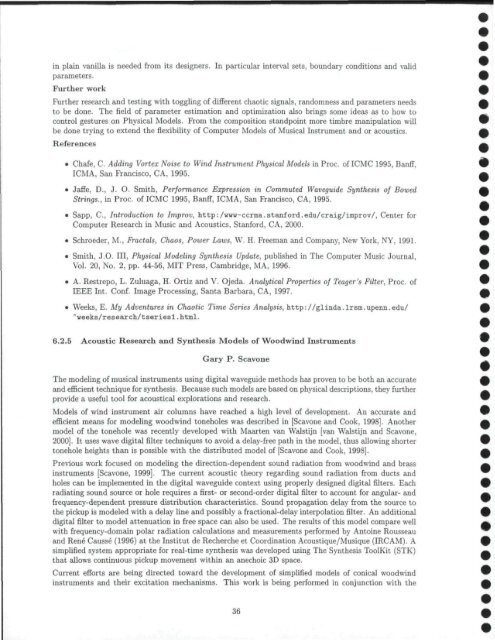CCRMA OVERVIEW - CCRMA - Stanford University
CCRMA OVERVIEW - CCRMA - Stanford University
CCRMA OVERVIEW - CCRMA - Stanford University
Create successful ePaper yourself
Turn your PDF publications into a flip-book with our unique Google optimized e-Paper software.
in plain vanilla is needed from its designers. In particular interval sets, boundary conditions and valid<br />
parameters.<br />
Further work<br />
Further research and testing with toggling of different chaotic signals, randomness and parameters needs<br />
to be done. The field of parameter estimation and optimization also brings some ideas as to how to<br />
control gestures on Physical Models. From the composition standpoint more timbre manipulation will<br />
be done trying to extend the flexibility of Computer Models of Musical Instrument and or acoustics.<br />
References<br />
• Chafe, C. Adding Vortex Noise to Wind Instrument Physical Models in Proc. of ICMC 1995, Banff,<br />
ICMA, San Francisco, CA, 1995.<br />
• Jaffe, D., J. O. Smith, Performance Expression in Commuted Waveguide Synthesis of Bowed<br />
Strings., in Proc. of ICMC 1995, Banff, ICMA, San Francisco, CA, 1995.<br />
• Sapp, C, Introduction to Improv, http:/www-ccrma.stanford.edu/craig/improv/, Center for<br />
Computer Research in Music and Acoustics, <strong>Stanford</strong>, CA, 2000.<br />
• Schroeder, M., Fractals, Chaos, Power Laws, W. H. Freeman and Company, New York, NY, 1991.<br />
• Smith, J.O. Ill, Physical Modeling Synthesis Update, published in The Computer Music Journal,<br />
Vol. 20, No. 2, pp. 44-56, MIT Press, Cambridge, MA, 1996.<br />
• A. Restrepo, L. Zuluaga, H. Ortiz and V. Ojeda. Analytical Properties of Teager's Filter, Proc. of<br />
IEEE Int. Conf. Image Processing, Santa Barbara, CA, 1997.<br />
• Weeks, E. My Adventures in Chaotic Time Series Analysis, http://glinda.lrsm.upenn.edu/<br />
"weeks/research/tseriesl.html.<br />
6.2.5 Acoustic Research and Synthesis Models of Woodwind Instruments<br />
Gary P. Scavone<br />
The modeling of musical instruments using digital waveguide methods has proven to be both an accurate<br />
and efficient technique for synthesis. Because such models are based on physical descriptions, they further<br />
provide a useful tool for acoustical explorations and research.<br />
Models of wind instrument air columns have reached a high level of development. An accurate and<br />
efficient means for modeling woodwind toneholes was described in [Scavone and Cook, 1998]. Another<br />
model of the tonehole was recently developed with Maarten van Walstijn [van Walstijn and Scavone,<br />
2000]. It uses wave digital filter techniques to avoid a delay-free path in the model, thus allowing shorter<br />
tonehole heights than is possible with the distributed model of [Scavone and Cook, 1998].<br />
Previous work focused on modeling the direction-dependent sound radiation from woodwind and brass<br />
instruments [Scavone, 1999]. The current acoustic theory regarding sound radiation from ducts and<br />
holes can be implemented in the digital waveguide context using properly designed digital filters. Each<br />
radiating sound source or hole requires a first- or second-order digital filter to account for angular- and<br />
frequency-dependent pressure distribution characteristics. Sound propagation delay from the source to<br />
the pickup is modeled with a delay line and possibly a fractional-delay interpolation filter. An additional<br />
digital filter to model attenuation in free space can also be used. The results of this model compare well<br />
with frequency-domain polar radiation calculations and measurements performed by Antoine Rousseau<br />
and Rene Causse (1996) at the Institut de Recherche et Coordination Acoustique/Musique (IRCAM). A<br />
simplified system appropriate for real-time synthesis was developed using The Synthesis ToolKit (STK)<br />
that allows continuous pickup movement within an anechoic 3D space.<br />
Current efforts are being directed toward the development of simplified models of conical woodwind<br />
instruments and their excitation mechanisms. This work is being performed in conjunction with the<br />
36

















